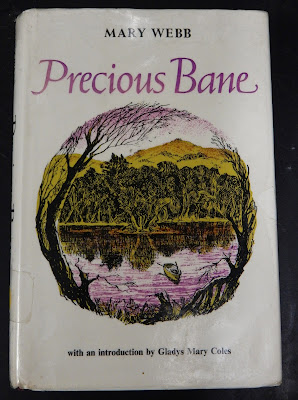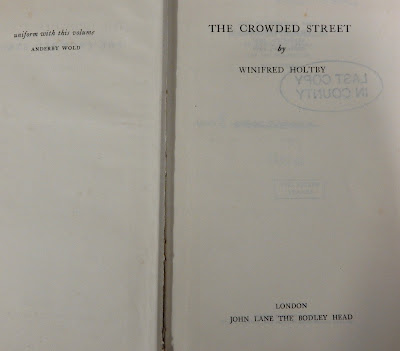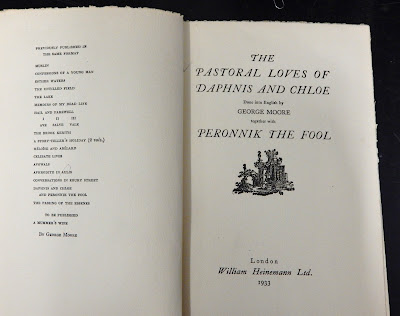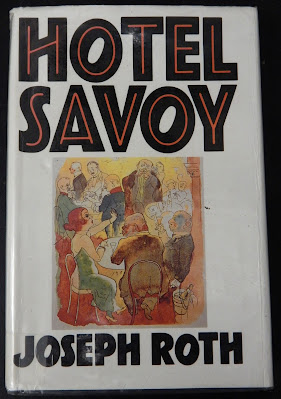Devon Libraries Centenary Collection - Part One: Fiction
This year (2024) marks the centenary of a county library service in Devon. The first county librarian was appointed in 1924 and a county library HQ set up in Colleton Crescent. It would be a while until Exeter got a public library of its own, however. A free library had been a part of the Royal Albert Memorial Museum since its opening in 1868, but there was a need for a dedicated building to meet ever increasing need and the expanding collection. A Carnegie Trust grant was offered in 1909 for the construction of a new site, but it wasn't until 1924 that agreement was reached for a plan to build in the grounds of Rougemont House. Things didn't exactly proceed rapidly from that point. A foundation stone was laid in 1928, but it wasn't until October 1930 that the new library had its official opening. It's life was fairly short. On the night of May 5th 1942, it was burned out by the fires started by incendiary bombs dropped during a German bombing raid. All but one of the books on its shelves were destroyed. That one book is now a precious relic, its hastily improvised wrapping preserved as a memorial to that terrible night.
After the war, the old building was patched up and a large number of new books bought to replace the destroyed stock. It soon became clear that the repaired building was inadequate for a city centre library. There was another considerable delay before a new building was constructed, the new library finally opening in 1965. That's the marvellous 60s modernist building that the central library still inhabits, and in which the stack is to be found. We have several copies of W.G.Hoskins' classic city history, A Thousand Years in Exeter (one of them signed by the man himself!), first published in 1960. Hoskins certainly didn't hold back in his opinions on the lack of an adequate library at this point in time. In his summary paragraphs at the end of the book, he fulminates that 'a century ago, two centuries ago, Exeter was a cultured place, the social and intellectual capital of a rich and varied province...Today the city library, burnt out nearly twenty years ago, is still a shambles. The failure to rebuild it is the greatest disgrace in the post-war history of the city. It is clear that books are not considered to be important in modern Exeter. How vastly different from our Victorian forefathers when they founded the Free Library in 1869!'
Mr Hoskins nothwithstanding, I thought it might be interesting to go sleuthing in the stacks and dig out some books which had first been published in 1924. Some of them have proved enduring, as indicated by the more recent editions on the shelves; others have been largely forgotten. Perhaps those long-neglected books give a greater insight into the popular tastes and trends of the time. Let's start by having a look at some of the fiction which would have been new to the library readers of 1924.
PG Wodehouse was already well-established as a comic writer by this time, having introduced the world to Jeeves and Wooster, Psmith and the inhabitants of Blandings Castle in the previous decade. His character Stanley Featherstonehaugh Ukridge is a lesser know creation, but Wodehouse was still writing stories about him in the 60s, so he proved an enduring one. Ukridge gathered together 10 of the initial stories about this workshy chancer.

Aldous Huxley's collection The Little Mexican is certainly not one of his best known books. He was still writing satirical novels at this time, and had found early success with Chrome Yellow and Antic Hay. Huxley was peripheral to the Bloomsbury set, the English artistic and literary group who were creating a peculiarly English sort of modernism at the time. EM Forster was much more central, and in 1924 published one of the major novels of the period - A Passage to India. The other literary monolith this year was Thomas Mann's The Magic Mountain. These are certainly the standout books of 1924 in terms of literary history. Another was sadly a posthumous collection. Katherine Mansfield had died the previous year. Something Childish was a selection of early short stories and others written at the same time as those published in Bliss and The Garden Party. Put together by her husband John Middleton Murry, it was the last collection of her masterful short stories.
At this point, I feel the urge to dash to the opposite end of the literary spectrum and dig out some raw pulp. Nobody produced more at this time than Edgar Wallace - and boy did he produce! No agonising over the perfect sentence here, he just churned them out. Due to post-war special subject areas assigned to county libraries, which included the collection of fiction authors whose surnames began with a particular letter, we have an abundance of Wallace (yes, our letter was W). That includes 6 novels first published in 1924. Beat that Huxley, Forster and Mann! So race through the thrill-packed pages of Dark Eyes of London, The Three Oak Mystery, The Face in the Night, Room 13 and The Sinister Man.

Another author whose work fills many shelves down in the stacks is Eden Phillpotts. His name is scarcely recognised today. If he's referred to at all it's usually in the context of his support for Agatha Christie in her early literary endeavours. He was a popular author in his day, though, known for his regional stories of Devon life. Hence our comprehensive collection. That includes his 1924 novel The Treasures of Typhon - not a Devonian idyll but a story set in classical Greece. Mary Webb was an author know for her rural tales, notably Gone To Earth, filmed by Powell and Pressburger in 1950. Precious Bane is one such, set in Shropshire in the early nineteenth century.
HG Wells was also a well-known personality at the time, an author of social novels and a popular educator. The science fiction for which he is known today was more or less behind him, the stories of alien invasion, time travel, mad scientists and space voyages which laid the foundations for the modern genre having been written in an intense period of creativity in the late Victorian and Edwardian period. The Dream briefly returns to the realms of science fiction, beginning in a utopian far future. But the titular dream experienced and related by an inhabitant of that future time is of the life of one of Wells' Edwardian everyman characters. There's an element of dreamlike time travel in Margaret Irwin's Still She Wished For Company, with two young women, one from modern day London and the other from the upper class world of the 1770s home counties, able to have glimpses of each other's lives.

John Galsworthy's The White Monkey is an installment in his ongoing Forsyte Saga series, memorably dramatised for television in the late 60s. Gilbert Frankau's Gerald Cranston's Lady is about a socially climbing man who marries for position, an interesting reversal of the usual scenario. A forgotten novel, it was also turned into a forgotten American film. Hugh Walpole is another author who was immensely popular in his day but is now largely forgotten. The Old Ladies details the lives of three women in their 70s who have fallen on hard times, and is set in the fictional town of Polchester, the setting for a number of his stories.
There is thrilling adventure from John Buchan in the form of Three Hostages, a novel featuring his dashing hero Richard Hannay. Hannay had appeared in three previous tales, including the 1915 classic The Thirty-Nine Steps, turned into a hugely successful film by Alfred Hitchcock in 1935. There's more adventure from future poet laureate John Masefield in his novel Sard Harker, a ripping yarn set in a fictional South American country. Harker may or may not be related to the Harker family who feature in his children's classics The Box of Delights and The Midnight Folk.
The Green Hat by Michael Arlen is very much of its time, centring as it does on the bright young things, the golden youth of the age. Arlen knew the world of which he wrote, having had an affair with Nancy Cunard, the shipping heiress who was a key player in the whole scene. The novel was later adapted into a 1928 MGM movie, A Woman of Affairs, starring Greta Garbo, John Gilbert and Douglas Fairbanks Jr – British aristocratic butterflies played by Hollywood royalty.
Dornford Yates was the pen name of one Cecil
William Mercer. He was qualified as a barrister, and in that guise was
peripherally involved in the Crippen murder case. His best known books fell
into two camps. The Chandos series were European set thrillers in the
light-hearted John Buchan mould. The Berry and Co books were comedies set in
the world of the aristocracy, and were not a million miles away from the works
of Wodehouse. And Five Were Foolish is a collection of short stories first
published in Windsor Magazine. In the book, each story bears the name of the
central female character. It was a great success, going through seven reprints
in the inter-war years.
Some Do Not by Ford Madox Ford was the first volume of his Parade’s End quartet. This sequence, which dealt with the war and its social and psychological prelude and aftermath, was regarded as a masterpiece at the time, and a key work of English modernism. It’s reputation has faded somewhat in recent times, although there was a 2012 BBC adaptation scripted by Tom Stoppard and starring Benedict Cumberpatch which brought it back to public attention. Alongside the two main male characters, there is a female character called Valentine Wannop, who is active in the Suffragette Movement, an acknowledgement of the impact the struggle for women’s rights was having on society at the time. Ford himself was living in Paris at the time of writing the novel. It was in 1924 that he met Jean Rhys there and encouraged her in her writing, as well as embarking on a brief affair with her (as we’ve seen in a previous post on Rhys).
The Crowded Street is the second novel by
Winifred Holtby, best known for her posthumous novel South Riding. Holtby
herself was born in the East Riding of Yorkshire. She was an active feminist
who held strong socialist and pacifist views. All of these beliefs were
expressed in her journalism, which was equally as important as her
novel-writing to her. Her close friendship with Vera Brittain was central to
her life, and Brittain chronicled that relationship in Testament of Friendship.
Brittain is probably the model for the character Delia in The Crowded Street.
Delia helps the protagonist, Muriel, escape from the strictures of family life
in the small Yorkshire town of Marshington, and from the social expectations
placed upon her as a woman.
Peronnik the Fool, combined in our stack copy
with Daphnis and Chloe, is an old Breton folkloric version of the Arthurian
Percival tale. Peronnik/Percival is the knight with humble origins who finds
the sacred objects (the spear and the grail) which restore the land to harmony
and prosperity. The translation here is by George Moore, an Irish writer who
was also an art critic, poet and dramatist. Moore had achieved scandalous
success with his 1883 novel A Modern Lover,
which was banned by circulating libraries and by WH Smith’s, all of which added
hugely to its popularity, of course. He also had a relationship with Lady
Cunard, mother of Nancy Cunard, who we have already encountered. Peronnik the
Fool is more in line with the Celtic Revival of Irish literature in the early
20th century, however, with which he was involved. He became friends with Lady
Gregory and WB Yeats and participated in the foundation of the Abbey Theatre in
Dublin, which became a centre for the Irish literary revival.
Dmitri Merezhkovsky was a Russian writer
associated with the Symbolist movement in the dying years of the nineteenth
century (and translated The Raven by Edgar Allan Poe, one of the Symbolists'
major influences). He was a vociferous critic of the the Bolshevik phase of the
Russian Revolution and thus an exile from the new Soviet Republic. He regarded
the ascendancy of Lenin and the Bolsheviks as the coming of the Kingdom of the
Anti-Christ. In the 20th century, he became the proponent of a 'new religious
consciousness', seeing himself as a revelatory prophet. Akhnaton King of Egypt
comes from a time when Merezhkovsky was turning to subjects from ancient
history to elucidate his grand spiritual and philosophical themes. Later in the
century, he would turn to the European dictators in his desire for a crusade
against the 'Antichrist' Soviet Union. Infamously, he compared Hitler with Joan
of Arc in a 1941 speech which was written but may or may not have been
broadcast on German radio. Naturally, his work went unpublished in the Soviet
Union up until its dissolution in the 1990s.
Walter White is probably best known today for
his historical role in the American Civil Rights Movement in the first half of
the twentieth century. He was the head of the NAACP (National Association for
the Advancement of Colored People from 1929 until his death in 1955. In the
1920s, he investigated lynchings in the South. His light skin allowed him to
present himself as a white man, although his parentage was African American and European, something which was potentially life-saving in the regions
through which he travelled. He was also able to effectively go undercover, making
contact with members of the Ku Klux Klan who were unaware that they were being
investigated. So successful was he in these covert operations that he was at
one time invited to join the KKK. White was also a part of the Harlem
Renaissance, the flowering of African American culture across the arts in the
1920s, and A Fire in the Flint was the first of two novels he wrote in that
decade. It drew on his experiences in the South in its story of an African
American doctor in Georgia who is forced into the position of fighting the
local KKK. It received positive reviews from many quarters, although not in
Georgia.
Hotel Savoy by Joseph Roth takes place in the titular establishment in Lodz, Poland. The hotel takes on an emblematic role, embodying the Europe of the post-war period. Its inhabitants feel marooned there, grasping towards a brighter future for themselves but unable to quite envisage how to get there. Roth himself was an Austrian Jewish writer who was a journalist as well as a novelist. Indeed, he was better known (and better paid) as the former at the time. He was good friends with the writer Stefan Zweig, who also chronicled the world of Central Europe in the aftermath of the collapse of the Hapsburg Empire. Both despaired at the rise of Hitler and the Nazi Party in the 30s. Roth's despair was reflected in his self-destructive alcoholism. His final book, The Legend of the Holy Drinker, was published shortly before his death in 1939.
So there, in a survey of 1924 fiction, we find
a broad summation of the state of the world at the time. Nostalgia for empires
lost or waning, struggles for equality for women and African Americans,
thrilling adventures across a politically volatile continent, comedies
featuring aristocratic dolts and society butterflies, Bright Young Moderns and Celtic Twilight revivalists, explorations of
mythological and symbolic dreamworlds, high literature and pulp page-turners.
Next we will turn our attention to non-fiction, plays and poetry published in
1924, covering everything from medieval history and Freudian psychology to memoirs
of imperial adventurers and legends of the Victorian theatre, surrealists and
absurdists, revolutionaries and a new breed of international celebrities.
































Comments
Post a Comment